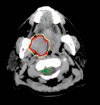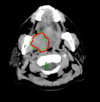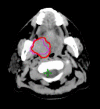18F-FDG PET/CT-based gross tumor volume definition for radiotherapy in head and neck cancer: a correlation study between suitable uptake value threshold and tumor parameters
- PMID: 20813064
- PMCID: PMC2942892
- DOI: 10.1186/1748-717X-5-76
18F-FDG PET/CT-based gross tumor volume definition for radiotherapy in head and neck cancer: a correlation study between suitable uptake value threshold and tumor parameters
Abstract
Background: To define a suitable threshold setting for gross tumor volume (GTV) when using 18Fluoro-deoxyglucose positron emission tomography and computed tomogram (PET/CT) for radiotherapy planning in head and neck cancer (HNC).
Methods: Fifteen HNC patients prospectively received PET/CT simulation for their radiation treatment planning. Biological target volume (BTV) was derived from PET/CT-based GTV of the primary tumor. The BTVs were defined as the isodensity volumes when adjusting different percentage of the maximal standardized uptake value (SUVmax), excluding any artifact from surrounding normal tissues. CT-based primary GTV (C-pGTV) that had been previously defined by radiation oncologists was compared with the BTV. Suitable threshold level (sTL) could be determined when BTV value and its morphology using a certain threshold level was observed to be the best fitness of the C-pGTV. Suitable standardized uptake value (sSUV) was calculated as the sTL multiplied by the SUVmax.
Results: Our result demonstrated no single sTL or sSUV method could achieve an optimized volumetric match with the C-pGTV. The sTL was 13% to 27% (mean, 19%), whereas the sSUV was 1.64 to 3.98 (mean, 2.46). The sTL was inversely correlated with the SUVmax [sTL = -0.1004 Ln (SUVmax) + 0.4464; R2 = 0.81]. The sSUV showed a linear correlation with the SUVmax (sSUV = 0.0842 SUVmax + 1.248; R2 = 0.89). The sTL was not associated with the value of C-pGTVs.
Conclusion: In PET/CT-based BTV for HNC, a suitable threshold or SUV level can be established by correlating with SUVmax rather than using a fixed threshold.
Figures







References
-
- Laubenbacher C, Saumweber D, Wagner-Manslau C, Kau RJ, Herz M, Avril N, Ziegler S, Kruschke C, Arnold W, Schwaiger M. Comparison of fluorine-18-fluorodeoxyglucose PET, MRI and endoscopy for staging head and neck squamous-cell carcinomas. J Nucl Med. 1995;36:1747–1757. - PubMed
-
- Kao CH, ChangLai SP, Chieng PU, Yen RF, Yen TC. Detection of recurrent or persistent nasopharyngeal carcinomas after radiotherapy with 18-fluoro-2-deoxyglucose positron emission tomography and comparison with computed tomography. J Clin Oncol. 1998;16:3550–3555. - PubMed
-
- Wong RJ, Lin DT, Schoder H, Patel SG, Gonen M, Wolden S, Pfister DG, Shah JP, Larson SM, Kraus DH. Diagnostic and prognostic value of [(18)F]fluorodeoxyglucose positron emission tomography for recurrent head and neck squamous cell carcinoma. J Clin Oncol. 2002;20:4199–4208. doi: 10.1200/JCO.2002.02.590. - DOI - PubMed
Publication types
MeSH terms
Substances
LinkOut - more resources
Full Text Sources
Medical

